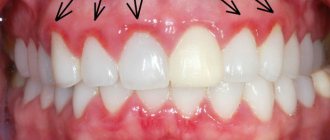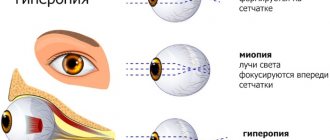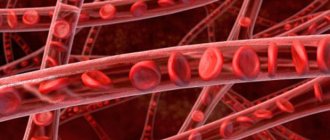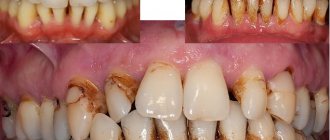Common lesions of oral tissue include gingivitis. They represent an inflammatory lesion of the gums. Although there are a number of gingivitis, differing in clinical picture and course, only one of them usually acts as a primary disease - catarrhal gingivitis. Other diseases of this kind mainly develop as complications.
The different forms of gingivitis differ in the complexity of the problem they create. The most difficult case is the atrophic form of gingivitis, which is almost impossible to completely cure, and which, in the absence of systematic therapy, leads to such severe consequences as periodontal disease and periodontitis. With the development of other types of gingivitis, the patient can achieve complete recovery. However, the primary task is to prevent various complications and timely diagnosis and treatment of the disease at the catarrhal stage.
Ulcerative-necrotizing gingivitis
The most acute and severe course is the ulcerative form of gingivitis. Compared to other inflammatory lesions of the gums, it is a rather rare phenomenon, usually found in young patients, no older than thirty years. Among patients with this disease there are many teenagers, as well as pregnant women. The reason for such statistics is that teenagers often neglect regular brushing of their teeth, and women's body resistance decreases during pregnancy. As a rule, the disease is acute, although in some cases it can become a chronic, relapsing process.
So, why does this disease develop, how does it progress, and what measures should be taken to treat it?
What is necrotizing ulcerative gingivitis?
Ulcerative-necrotizing gingivitis is an inflammatory disease that affects the gums, developing as a result of infection of their mucous membrane and proceeding with the development of ulcerative defects in the absence of damage to the periodontal pockets. In dental practice, the disease is also called Vincent gingivitis . The disease can be either primary or complicate other infectious pathologies of the oral cavity. Most often occurs in young people aged 20-30 years.
Causes of necrotizing ulcerative gingivitis
There are both local ones, affecting the oral cavity, and general prerequisites for the development of the disease.
Local reasons are:
- insufficient oral hygiene,
- permanent injury to the gums due to improper brushing techniques,
- complicated eruption of wisdom teeth,
- chronic infections localized in the oral cavity (caries, stomatitis),
- incorrectly selected or installed dentures, braces, dental fillings,
Factors affecting the entire body include:
- immunodeficiency states of any origin (HIV infection, tuberculosis, while taking cytostatics and immunosuppressants),
- hypovitaminosis,
- concomitant endocrine pathology (diabetes mellitus, hypothyroidism),
- radiation sickness,
- pathology of the cardiovascular system,
- hormonal disorders,
- smoking,
- acute poisoning of the body,
- prolonged stress and lack of sleep,
Treatment of gingivitis in adults
The most common question from periodontal patients is: “how to treat gum disease?” There are several types of treatment for gingivitis in dentistry:
- Drug treatment.
- Hardware treatment.
Since the main cause of gingivitis is bacterial microflora and hard plaque, professional oral hygiene is the first step. After eliminating the cause of gum inflammation, medications are prescribed to treat gingivitis.
Medicines for the treatment of gingivitis
Treatment of gingivitis with tablets and ointments is prescribed by a doctor after accurately establishing the cause of the disease and identifying the symptoms. The use of traditional medicine and self-medication can have a detrimental effect on the further course of the disease.
Hardware treatment of gum inflammation
In order to completely cure inflamed gums, dentists perform professional dental hygiene. Cleaning the oral cavity is carried out in the following steps:
- Bacterial plaque and pigmented plaque are removed from all tooth surfaces using special brushes and pastes.
- Hard dental deposits are removed using an ultrasonic device or manual scalers.
- After complete removal of plaque, the enamel is polished with polishing heads and soft brushes.
- Inflamed and bleeding gums are treated with an aqueous solution of chlorhexidine or hydrogen peroxide.
- If necessary, reminarilization therapy is carried out (for increased tooth sensitivity).
Gels and ointments for gingivitis
To eliminate local symptoms of gingivitis (inflammation, swelling, pain), anti-inflammatory and antiseptic gels and ointments are prescribed. Any ointment for gingivitis should contain antiseptic and antibacterial substances (chlorhexidine, metronidazole), as well as anti-inflammatory components (benzydamine hydrochloride, herbal substances).
Examples of effective ointments and gels against gum inflammation include:
- "Metrogil denta";
- "Dentamet";
- "Holisal";
- "Dentinox."
Local medications are prescribed for a period of no more than 10–14 days. Frequent use of medicinal ointments is not recommended due to the possible addiction of the body.
How to choose toothpaste
During the treatment of gingivitis, it is recommended to use: a soft or medium-hard toothbrush (depending on the clinical picture) and therapeutic and prophylactic toothpastes. Toothpaste for gingivitis should include medicinal components (herbs, antiseptics, regenerating substances).
For inflammatory gum diseases, the following toothpastes are recommended:
- "Lacalut active";
- "Parodontax";
- Sensodyne;
- "Splat ACTIVE";
- "ROCS bionica".
The paste is selected by the dentist based on the characteristics of the course of gingivitis, the physiology of the oral cavity and the wishes of the patient.
Nutritional Features
Nutrition plays a special role in the treatment of gingivitis. The diet should include such foods as:
- citrus;
- pears and apples;
- red vegetables (carrots, bell peppers);
- grape.
It is recommended to avoid foods containing fast carbohydrates (white bread, sugar, pastries). The decomposition of fast sugars leads to the production of substances favorable for the life of pathogenic bacteria. You also need to exclude spicy and salty foods, which provoke irritation of the mucous tissue.
Symptoms of necrotizing ulcerative gingivitis
- acute onset of the disease with an increase in temperature to 38-39 degrees,
- headache, weakness,
- redness and swelling of the gums,
- increased bleeding of the mucous membranes of the gums,
- enlargement of the submandibular and cervical lymph nodes in severe cases of the disease,
- the formation of erosions and ulcers on the 2-3rd day of illness in the area of the gum papillae and their edges, covered with fibrous plaque,
- bad breath,
- increased production of salivary fluid,
- difficulty speaking due to severe pain,
Symptoms
Inflammation of the gums in children starts with the following manifestations:
- bad breath;
- gums bleed;
- Erosion appears on their surface.
These symptoms of manifest gingivitis are caused by irregular teeth brushing, but can occur when the immune system is weakened as a result of poor nutrition or a violation of the psychological state.
With chronic progression of gingivitis, pain may not occur. Exacerbations occur twice a year and are characterized mainly by the formation of dentolits.
Symptoms of the disease
The main symptoms of different versions of gingivitis are not the same. Doctors identify the following options for the development of the disease:
- catarrhal;
- hypertrophied;
- atrophic;
- pitting.
Important! The occurrence of gingivitis is preceded by the formation of dental plaque and dentolits.
Manifest catarrhal gingivitis occurs mainly during teething , replacement of milk teeth with permanent ones or infectious pathologies. The child’s gums bleed when he brushes his teeth, and his saliva turns pinkish. The pain intensifies when eating hot, cold, sour food or drink. The temperature with catarrhal gingivitis in children is normal or low-grade.
Characteristic for this variant of the disease is swelling and bluish hyperemia of the gums. The mucous membrane of the gums is loose, thickened, flaking. Touching causes bleeding. Single erosions are observed.
Hypertrophied gingivitis is a permanent inflammation of the gums with the formation of edema or granulation, which occurs mainly during the period of maturation. In the first situation, children's gums bleed. They itch and hurt, especially when eating. A teenager cannot fully chew food with his teeth.
With the granulating (fibrous) form of gingivitis, the papillae hypertrophy, resulting in gums in the child . It grows, covers the crowns, imaginary pockets form, and a thick layer of plaque is deposited on the teeth. In severe cases pus is released and becomes bluish-purple in color.
Atrophic gingivitis occurs with congenital anomalies of the frenulum or unsuccessful manipulations to correct the bite. This form of gingivitis is less bothersome than others.
There is no or minimal inflammatory reaction, however, the gum margin is reduced, exposing the dental neck. Nerve endings come to the surface, reacting with pain to contact with hot or cold food or drink.
Ulcerative gingivitis develops from the catarrhal form with inadequate treatment or its absence. The course of the disease is aggravated by infections, as well as hypothermia. Defects form at the edge of the gum. They become covered with a foul-smelling greenish-gray coating, and the saliva becomes extremely viscous. Appetite is disrupted, sleep is lost, the child is capricious.
The temperature during gingivitis in children reaches 39°, which indicates an increase in symptoms of intoxication. Local lymph nodes hypertrophy.
Types of ulcerative-necrotizing gingivitis
Acute ulcerative gingivitis
Acute Vincent gingivitis is caused primarily by fusobacteria and spirochetes and most often develops as a result of other oral infections. The acute form of the disease is characterized by a rapid onset and development of symptoms - the full clinical picture appears by 2-3 days of illness. The incidence increases in cold seasons, which is associated with frequent hypothermia, viral infections and a decrease in the overall reactivity of the body.
The occurrence of acute necrotizing ulcerative gingivitis can serve as one of the first manifestations of AIDS.
Chronic ulcerative gingivitis
This form of the disease occurs mainly in adolescents and occurs over several years due to improper or incomplete oral hygiene. Symptoms appear gradually - first there is increased bleeding of the gums when brushing teeth or eating and their swelling, later bad breath develops and isolated erosions and ulcers are detected.
How to treat gingivitis?
Since gingivitis is a viral infection, antibiotics will not help. Treatment of gingivitis includes measures to prevent the development of a viral infection. Your child's mouth sores should heal in a week or two. To help relieve your child's pain, you can take the following steps:
Give your child children's acetaminophen or ibuprofen, which will help relieve pain and reduce fever. (Caution: Never give aspirin to children under 20 years of age. This may cause the development of a rare but very dangerous disease known as Reine's syndrome.) If the pain is too severe and your child is unable to eat even after taking painkillers that You can buy it without a prescription, then you should contact your pediatrician to prescribe a stronger painkiller.
Although your child may refuse to drink due to severe pain when swallowing, it is very important that he drinks plenty of fluids. Offer your baby cool, non-acidic, non-carbonated drinks such as water, milkshakes or diluted apple juice. One of the complications of gingivitis in children is dehydration, which occurs especially quickly in young children. A doctor should be called to your home if your child has not gone to the toilet or drunk for 6 hours, or if there are signs of dehydration.
Offer your child cool, pain-relieving foods such as ice cream, frozen yogurt, or bland foods that do not require chewing, such as mashed potatoes, yogurt, or apple mousse/sauce.
Stages of development of Vincent's gingivitis
Mild degree
It is characterized by limited single inflammations of the gum papillae with not deep ulcerative defects. The patient’s general well-being does not suffer, only soreness of the gums is noted when they come into contact with a toothbrush or rough food, and the presence of bad breath.
Moderate severity
Inflammation affects not only the interdental papillae and the tops of the gums, but also the free edges of the gums. Low-grade body temperature, general malaise, bleeding gums and swelling are detected. As a rule, ulcerative defects are located in groups, more on the front side of the gums.
Severe degree
Body temperature rises to 38-39 degrees, ulcerative defects are multiple and deep, can reach muscle tissue and bone structures, massive fibrin deposits are visualized at the bottom of the ulcers. The patient’s health deteriorates sharply, and regional lymph nodes enlarge. Severe Vincent gingivitis can lead to osteomyelitis of the affected area of the jaw.
Hypertrophic gingivitis in children and its symptoms
Hypertrophic gingivitis affects areas of the anterior lower and upper jaw. But the severity of hypertrophic gingivitis can only be determined by a specialist.
Symptoms:
- the gums become purple with a bluish tint;
- bad breath;
- opening the bottom of the tooth;
- development of purulent processes;
- swelling of the gums.
In case of hypertrophic gingivitis, you should immediately consult a doctor. Otherwise, such gingivitis can become chronic with complications.
Diagnosis of necrotizing ulcerative gingivitis
Based on an examination of the oral cavity by a dentist and the patient’s characteristic complaints. Upon examination, ulcerative defects of the gums, supragingival tartar and increased bleeding are revealed, while periodontal pockets are not detected.
Laboratory and instrumental research methods:
- Complete blood count (leukocytosis, increased erythrocyte sedimentation rate).
- Bacteriological examination of ulcerative plaque (detection of fusobacteria and spirochetes in a smear) and determination of the sensitivity of the identified pathogen to the antimicrobial spectrum.
- ELISA and RIF for determining bacterial antigens in saliva.
- Determination of the level of immunoglobulin A in salivary fluid, indicating local inflammation.
- Orthopantomography to assess the condition of the bone structures of the jaws; the study is especially important in severe cases of the process.
- Rheoparodontography, carried out to assess the circulation of capillary blood in periodontal tissues.
Diagnosis of gingivitis
A patient with gingivitis is examined. The doctor clarifies how long ago the first symptoms of discomfort appeared.
An examination of the oral cavity involves the following activities:
- Assessment of bite, lip frenulum, mucous membranes.
- Assessment of the condition of the palate, cheeks, pharynx, tongue.
- Assessment of the condition of teeth, the presence of caries, stone, soft plaque, pulpitis.
- Assessment of the color and structure of the gums, determination of bleeding, the presence of purulent lesions.
After such an examination, the doctor can assess the severity of the pathology.
If necessary, the doctor will refer the patient for additional examination.
This may include:
- Radiography. This method allows you to distinguish gingivitis from periodontitis.
- Donating blood for a general analysis. The study allows you to assess your overall health and determine the absence of blood diseases.
- Blood for biochemical analysis. This study provides information about diabetes mellitus.
- Donating blood for HIV and syphilis.
- A microbiological study that allows us to clarify the representatives of the bacterial flora living in the oral cavity.
Treatment of ulcerative-necrotizing gingivitis
Therapy for Vincent's gingivitis is aimed both at eliminating local manifestations of the disease and at overall strengthening the body.
- Professional teeth cleaning in a dental clinic, aimed at completely removing dental plaque and areas of dead tissue, washing ulcerative defects with antiseptic solutions. The procedure is performed under local anesthesia.
- Compresses with anesthetic drugs (Lidocaine, Novocaine) to relieve pain.
- Prescription of antimicrobial drugs taking into account the sensitivity of the identified pathogen (Metronidazole, Trichomonacid, penicillin antibiotics).
- The use of proteolytic enzymes to cleanse erosions and ulcers from necrotic masses (Trypsin, Himopsin, Terrylitin).
- Regular rinsing of the mouth with antiseptic solutions (Chlorhexidine, Miramistin).
- Applications with keratoplasty drugs to accelerate tissue regeneration (Actovegin, Methyluracil, rosehip oil).
- The use of non-steroidal anti-inflammatory drugs that help relieve pain and eliminate the inflammatory process (Indomethacin, Ketoprofen, Diclofenac).
- Vitamin preparations of groups C and P (Ascorbic acid, Ascorutin, Quercetin).
- Physiotherapeutic treatment (UVR, electrophoresis, ultraphonophoresis).
- A diet aimed at mechanically sparing the gums and enriched with proteins and vitamins.
- Drink plenty of fluids.
Treatment
Elimination of such a disease is individual, but complex. First of all, you should eliminate the root cause - this may require:
- neutralization of caries;
- adjustment of orthodontic systems is performed according to individual indications;
- plastic surgery of the frenulum of the tongue, mucosal cords or lips;
- rehabilitation of infections localized in the nasopharynx;
- professional oral hygiene;
- relief of somatic ailments.
Tongue frenulum
It is precisely because of this approach in the treatment of catarrhal gingivitis in children or any other type of disease that at one stage or another, specialists from various fields of medicine can take part in therapy. Therefore, help is needed:
- pediatric orthodontist and dental surgeon;
- pediatric endocrinologist or gastroenterologist;
- pediatrician;
- pediatric otolaryngologist or allergist-immunologist.
After dental cleaning of the mouth, the following procedures may sometimes be required:
- intraoral electrophoresis;
- laser therapy of the mucous membrane;
- diathermoregulation or cryodestruction of gingival papillae;
- gingivoplasty;
- Ural Federal District.
Treatment at home involves:
- rinsing the mouth with antiseptic solutions, as well as healing decoctions of medicinal herbs and plants recommended by the clinician;
- implementation of applications with medicinal gels;
- treating the gum mucosa with antiseptics - only in this form can antibiotics be used for gingivitis in a child;
- oral intake of vitamins;
- proper nutrition - minimizing the consumption of carbohydrates and enriching the menu with fruits and vegetables.
Prevention of necrotizing ulcerative gingivitis
In order to prevent the recurrence of Vincent's gingivitis, patients who have suffered from the disease are recommended to visit the dentist 3-4 times a year to monitor the condition of the gums and timely remove tartar deposits.
Measures to prevent the primary development of pathology include maintaining oral hygiene, sanitizing foci of chronic infection located in the oral cavity, eliminating bad habits (smoking, drinking alcohol), treating endocrine diseases and generally strengthening the body's defenses.
Etiology and pathogenesis of ulcerative gingivitis
Vincent's gingivitis is caused by dental spirochetes and fusobacteria, which are part of the normal microflora of the oral cavity. The development of the disease is facilitated by a breakdown of the general and local immune systems, which leads to increased proliferation of bacteria on the mucous membranes, the antigens and waste products of which cause an immune-infectious inflammatory process in the gums. Ulcerative defects are formed when the pathogen penetrates the gum tissue and their subsequent reproduction.
Necrotizing ulcerative inflammation of the gums is a serious disease of the oral cavity, which without proper treatment can lead to a number of serious problems, therefore, at the first signs of gum damage, you should immediately visit a dental clinic and consult a doctor.








